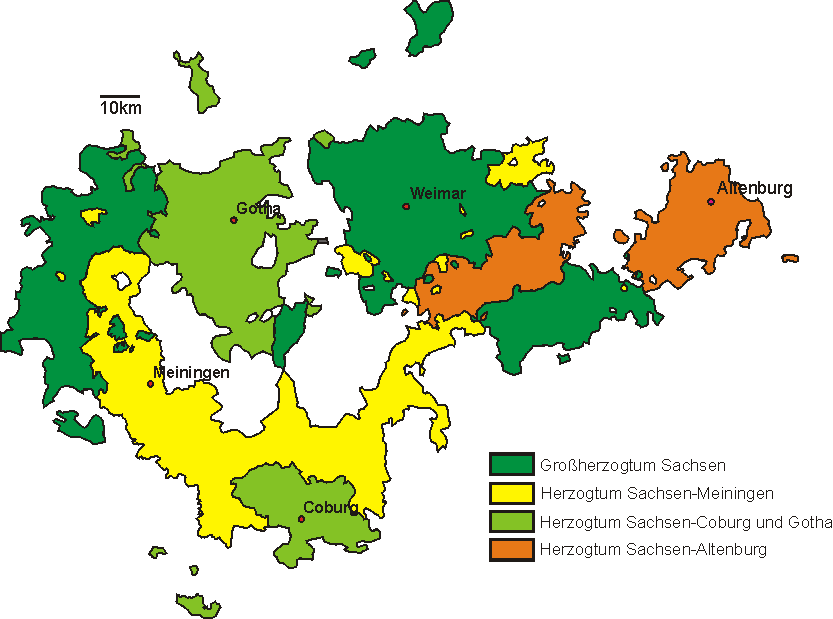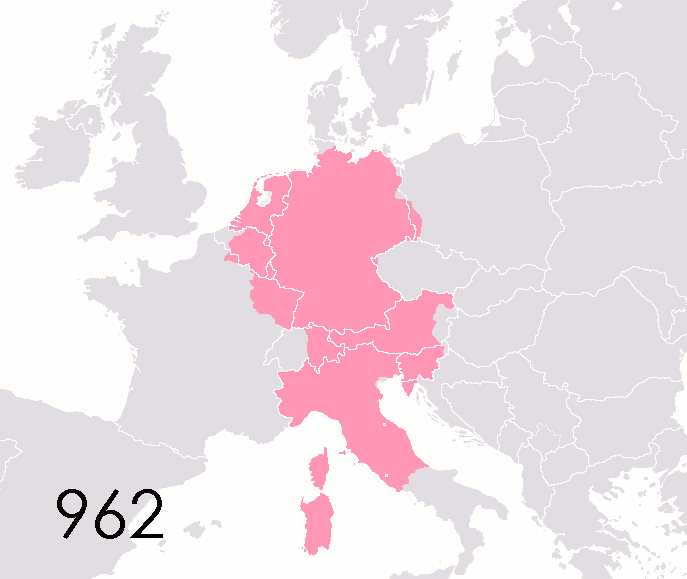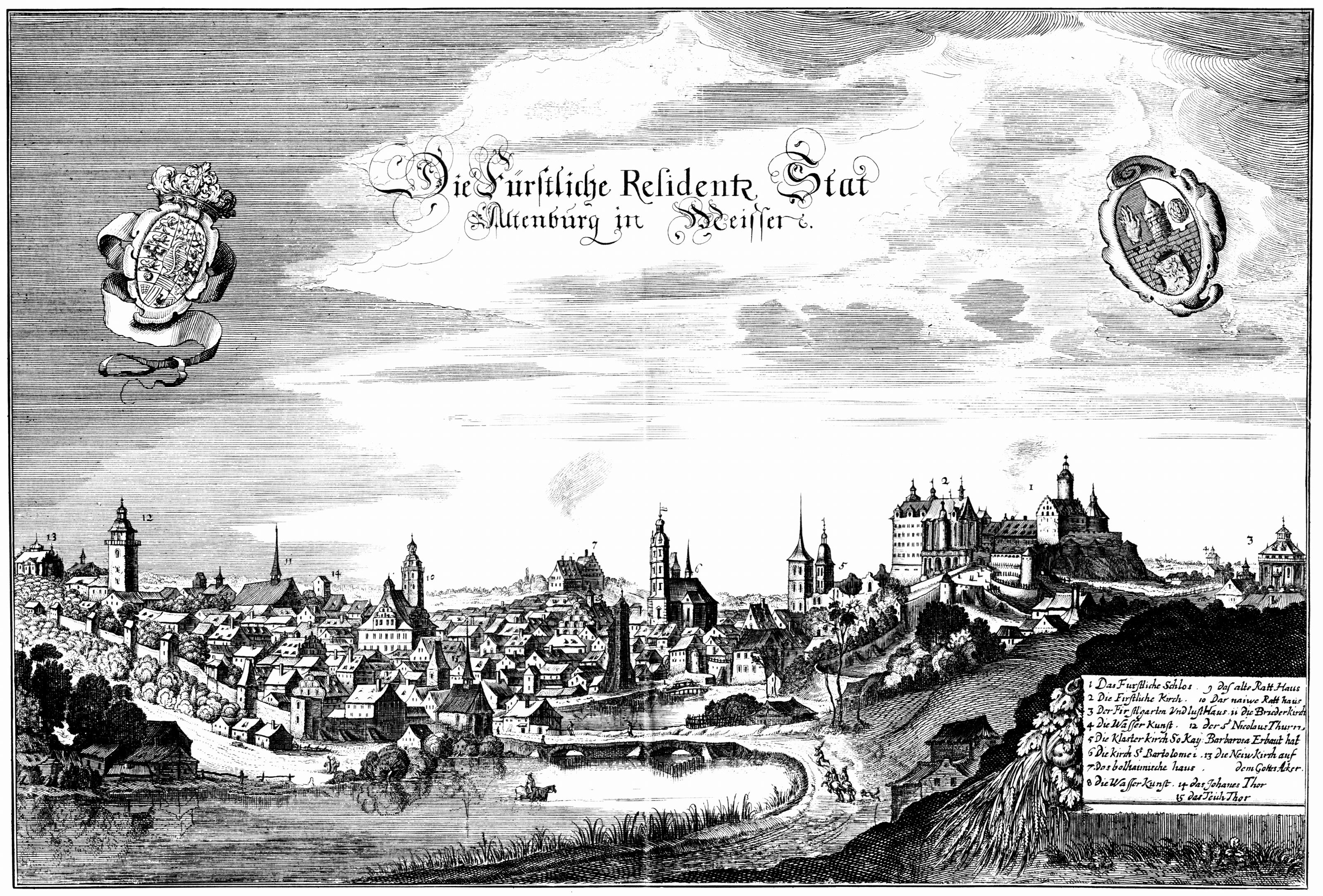|
Duchy Of Saxe-Altenburg
Saxe-Altenburg (german: Sachsen-Altenburg, links=no) was one of the Saxon duchies held by the Ernestine branch of the House of Wettin in present-day Thuringia. It was one of the smallest of the German states with an area of 1323 square kilometers and a population of 207,000 (1905) of whom about one fifth resided in the capital, Altenburg. The territory of the duchy consisted of two non-contiguous territories separated by land belonging to the Principality of Reuss. Its economy was based on agriculture, forestry, and small industry. The state had a constitutional monarchical form of government with a parliament composed of thirty members chosen by male taxpayers over 25 years of age. History The duchy had its origins in the medieval Burgraviate of Altenburg in the Imperial Pleissnerland ''(Terra Plisensis)'', a possession of the Wettin Margraves of Meissen since 1243. Upon a partition treaty of 1485, Altenburg fell to Ernst, Elector of Saxony, the progenitor of the Ernestine We ... [...More Info...] [...Related Items...] OR: [Wikipedia] [Google] [Baidu] |
States Of The Holy Roman Empire
This list of states in the Holy Roman Empire includes any territory ruled by an authority that had been granted imperial immediacy, as well as many other feudal entities such as lordships, sous-fiefs and allodial fiefs. The Holy Roman Empire was a complex political entity that existed in central Europe for most of the medieval and early modern periods and was generally ruled by a German-speaking Emperor. The states that composed the Empire, while enjoying a unique form of territorial authority (called '' Landeshoheit'') that granted them many attributes of sovereignty, were never fully sovereign states in the sense that term is understood today. In the 18th century, the Holy Roman Empire consisted of approximately 1,800 such territories, the majority being tiny estates owned by the families of Imperial Knights. This page does not directly contain the list but discusses the format of the various lists and offers some background to understand the complex organisation of the Holy R ... [...More Info...] [...Related Items...] OR: [Wikipedia] [Google] [Baidu] |
Johann Philipp, Duke Of Saxe-Altenburg
Johann Philipp (25 January 1597 – 1 April 1639), was a duke of Saxe-Altenburg. He was born in Torgau, the eldest (but fourth in order of birth) surviving son of Friedrich Wilhelm I, Duke of Saxe-Weimar and Anna Maria of the Palatinate-Neuburg, his second wife. Childhood When his father died (1602), Johann Philipp and his younger brothers Frederick, Johann Wilhelm and Friedrich Wilhelm were underage. Because of this, his uncle Johann (more interested in natural sciences and art than politics) took over his guardianship and the regency of his inheritance; but shortly after he took all the duchy of Saxe-Weimar into his own hands. The next year (1603), the young prince of Saxe-Weimar demanded his own inheritance, but his uncle Johann opposed this. But finally, both parts made a divisionary treaty of the family lands: Johann Philipp and his brothers took Altenburg and some towns, and Johann retained Weimar and Jena. Because they were still underage, the regency of his duchy ... [...More Info...] [...Related Items...] OR: [Wikipedia] [Google] [Baidu] |
Schloss Altenburg 02
''Schloss'' (; pl. ''Schlösser''), formerly written ''Schloß'', is the German term for a building similar to a château, palace, or manor house. Related terms appear in several Germanic languages. In the Scandinavian languages, the cognate word ''slot''/''slott'' is normally used for what in English could be either a palace or a castle (instead of words in rarer use such as ''palats''/''palæ'', ''kastell'', or ''borg''). In Dutch, the word ''slot'' is considered to be more archaic. Nowadays, one commonly uses ''paleis'' or ''kasteel''. But in English, the term does not appear, for instance, in the United Kingdom, this type of structure would be known as a stately home or country house. Most ''Schlösser'' were built after the Middle Ages as residences for the nobility, not as true fortresses, although originally, they often were fortified. The usual German term for a true castle is ''burg'', that for a fortress is ''festung'', and — the slightly more archaic term — ... [...More Info...] [...Related Items...] OR: [Wikipedia] [Google] [Baidu] |
Principality Of Reuss
Reuss (german: Reuß , ) was the name of several historical states located in present-day Thuringia, Germany. Several lordships of the Holy Roman Empire which arose after 1300 and became Imperial Counties from 1673 and Imperial Principalities in the late 18th century were ruled by the House of Reuss. A varying number of these counties came into being by partition; they were partially merged and divided again. After the end of the empire in 1806, the principality of the elder line, as well as several of the younger, became sovereign member states of the German Confederation, with the younger ones merging into a unified principality by 1848. The two remaining territories became federal principalities of the German Empire in 1871, the Principality of Reuss Elder Line with the state capital of Greiz and the Principality of Reuss Younger Line with the state capital of Gera. Both states were ruled by the House of Reuss until the German Revolution of 1918–1919. The head of each b ... [...More Info...] [...Related Items...] OR: [Wikipedia] [Google] [Baidu] |
Altenburg
Altenburg () is a city in Thuringia, Germany, located south of Leipzig, west of Dresden and east of Erfurt. It is the capital of the Altenburger Land district and part of a polycentric old-industrial textile and metal production region between Gera, Zwickau and Chemnitz with more than 1 million inhabitants, while the city itself has a population of 33,000. Today, the city and its rural county is part of the Central German Metropolitan Region. Altenburg was first mentioned in 976 and later became one of the first German cities within former Slavic area, east of the Saale river (as part of the medieval Ostsiedlung movement). The emperor Frederick I, Holy Roman Emperor, Frederick Barbarossa visited Altenburg several times between 1165 and 1188, hence the town is named a Barbarossa city, Barbarossa town today. Since the 17th century, Altenburg was the residence of different House of Wettin, Ernestine duchies, of whom the Duchy of Saxe-Altenburg, Saxe-Altenburg persisted until th ... [...More Info...] [...Related Items...] OR: [Wikipedia] [Google] [Baidu] |
House Of Wettin
The House of Wettin () is a dynasty of German kings, prince-electors, dukes, and counts that once ruled territories in the present-day German states of Saxony, Saxony-Anhalt and Thuringia. The dynasty is one of the oldest in Europe, and its origins can be traced back to the town of Wettin, Saxony-Anhalt. The Wettins gradually rose to power within the Holy Roman Empire. Members of the family became the rulers of several medieval states, starting with the Saxon Eastern March in 1030. Other states they gained were Meissen in 1089, Thuringia in 1263, and Saxony in 1423. These areas cover large parts of Central Germany as a cultural area of Germany. The family divided into two ruling branches in 1485 by the Treaty of Leipzig: the Ernestine and Albertine branches. The older Ernestine branch played a key role during the Protestant Reformation. Many ruling monarchs outside Germany were later tied to its cadet branch, the House of Saxe-Coburg and Gotha. The Albertine branch, while less ... [...More Info...] [...Related Items...] OR: [Wikipedia] [Google] [Baidu] |
Reuß
Reuss (german: Reuß , ) was the name of several historical states located in present-day Thuringia, Germany. Several lordships of the Holy Roman Empire which arose after 1300 and became Imperial Counties from 1673 and Imperial Principalities in the late 18th century were ruled by the House of Reuss. A varying number of these counties came into being by partition; they were partially merged and divided again. After the end of the empire in 1806, the principality of the elder line, as well as several of the younger, became sovereign member states of the German Confederation, with the younger ones merging into a unified principality by 1848. The two remaining territories became federal principalities of the German Empire in 1871, the Principality of Reuss Elder Line with the state capital of Greiz and the Principality of Reuss Younger Line with the state capital of Gera. Both states were ruled by the House of Reuss until the German Revolution of 1918–1919. The head of each b ... [...More Info...] [...Related Items...] OR: [Wikipedia] [Google] [Baidu] |
Schwarzburg-Rudolstadt
Schwarzburg-Rudolstadt was a small historic state in present-day Thuringia, Germany, with its capital at Rudolstadt. History Schwarzburg-Rudolstadt was established in 1599 in the course of a resettlement of Schwarzburg dynasty lands. Since the 11th century, the ancestral seat of the comital family had been at Schwarzburg Castle, though after 1340, for most of its existence as a polity had the capital at the larger town of Rudolstadt. In 1583 Count Günther XLI of Schwarzburg, the eldest son of Günther XL the Rich and ruler over the united Schwarzburg lands, had died without issue. He was succeeded by his younger brothers, whereby Albert VII received the territory around Rudolstadt. After their brother Count William of Schwarzburg- Frankenhausen had died in 1597, the surviving brothers Albert VII and John Günther I established the two counties of Schwarzburg-Rudolstadt and Schwarzburg-Sondershausen by the 1599 Treaty of Stadtilm. Albert's descendants ruled as sovereign count ... [...More Info...] [...Related Items...] OR: [Wikipedia] [Google] [Baidu] |
Schwarzburg-Sondershausen
Schwarzburg-Sondershausen was a small principality in Germany, in the present day state of Thuringia, with its capital at Sondershausen. History Schwarzburg-Sondershausen was a county until 1697. In that year, it became a principality, which lasted until the fall of the German monarchies in 1918, during the German Revolution of 1918–1919. After the German Revolution, it became a republic and joined the Weimar Republic as a constituent state. In 1920, it joined with other small states in the area to form the new state of Thuringia. Schwarzburg-Sondershausen had an area of 862 km² (333 sq. mi.) and a population of 85,000 (1905). Towns placed in the state were: Arnstadt, Sondershausen, Gehren, Langewiesen, Großbreitenbach, Ebeleben, Großenehrich, Greußen and Plaue. Rulers of Schwarzburg-Sondershausen, 1552–1918 Counts of Schwarzburg-Sondershausen * 1552–1586 John Günther I * 1586–1631 Günther XLII, ''with'' Anton Henry, John Günther II and Christian ... [...More Info...] [...Related Items...] OR: [Wikipedia] [Google] [Baidu] |
Saxe-Weimar-Eisenach
Saxe-Weimar-Eisenach (german: Sachsen-Weimar-Eisenach) was a historical German state, created as a duchy in 1809 by the merger of the Ernestine duchies of Saxe-Weimar and Saxe-Eisenach, which had been in personal union since 1741. It was raised to a grand duchy in 1815 by resolution of the Vienna Congress. In 1903, it officially changed its name to the Grand Duchy of Saxony (german: Großherzogtum Sachsen), but this name was rarely used. The Grand Duchy came to an end in the German Revolution of 1918–19 with the other monarchies of the German Empire. It was succeeded by the Free State of Saxe-Weimar-Eisenach, which was merged into the new Free State of Thuringia two years later. The full grand ducal style was Grand Duke of Saxe-Weimar-Eisenach, Landgrave in Thuringia, Margrave of Meissen, Princely Count of Henneberg, Lord of Blankenhayn, Neustadt and Tautenburg. The Saxe-Weimar-Eisenach branch has been the most genealogically senior extant branch of the House of We ... [...More Info...] [...Related Items...] OR: [Wikipedia] [Google] [Baidu] |
Saxe-Coburg-Gotha
Saxe-Coburg and Gotha (german: Sachsen-Coburg und Gotha), or Saxe-Coburg-Gotha (german: Sachsen-Coburg-Gotha, links=no ), was an Ernestine, Thuringian duchy ruled by a branch of the House of Wettin, consisting of territories in the present-day states of Thuringia and Bavaria in Germany. It lasted from 1826 to 1918. In November 1918, Charles Edward, Duke of Saxe-Coburg and Gotha, was forced to abdicate. In 1920, the northern part of the duchy (since 1918 the Free State of Gotha; culturally and linguistically Thuringian) was merged with six other Thuringian free states to form the Free State of Thuringia: Saxe-Weimar-Eisenach (until 1918 a grand duchy), Saxe-Altenburg and Saxe-Meiningen (until 1918 duchies), Schwarzburg-Rudolstadt and Schwarzburg-Sondershausen (until 1918 principalities), as well as the People's State of Reuss (until 1918 the principalities of Reuss-Gera and Reuss-Greiz). The southern part of the duchy (since 1918 the Free State of Coburg; culturally and ling ... [...More Info...] [...Related Items...] OR: [Wikipedia] [Google] [Baidu] |






